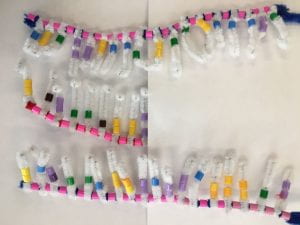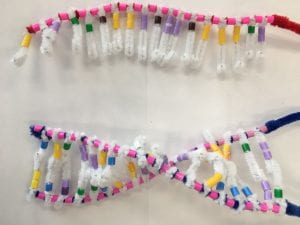Transcription:
Messenger ribonucleic acid (mRNA) is different than DNA because its nucleotides contain ribose sugar instead of deoxyribose sugar. The nitrogenous base uracil replaces thymine found in DNA. mRNA is single-stranded and does not form a double helix in the same manner as DNA.
Transcription is the making of an RNA molecule that is complementary to a portion of DNA. This occurs in the nucleus of a cell. The enzyme RNA polymerase causes a segment of the DNA double helix to unwind and “unzip”.
Complementary RNA nucleotides from an RNA nucleotide pool in the nucleus pair with the DNA nucleotides of one strand.
RNA polymerase joins the RNA nucleotides.
An mRNA molecule results. It has a sequence of codons—three bases—that is complementary to the DNA triplet code.
Following transcription, the mRNA molecule passes out of the nucleus and enters the cytoplasm.
Today’s activity did a good job of modelling the process of RNA transcription by modelling many of the structural differences between DNA and mRNA. It used different coloured beads to differentiate between thymine and uracil, and modelled how mRNA has a single backbone. It also modelled how RNA polymerase works in RNA transcription. Our model was inaccurate in the way that the DNA molecule and the mRNA molecule are the same size. A DNA molecule is much larger than an mRNA molecule. In RNA transcription, only a portion of DNA is used to make an mRNA molecule. In the model, the entire DNA molecule is used.
Translation:
Translation is the use of an mRNA molecule to sequence the amino acids of a polypeptide. This takes place in the cytoplasm of a eukaryotic cell.
Initiation:
A small ribosomal subunit attaches to the mRNA strand in the vicinity of the start codon (AUG).
The initiator (first) tRNA pairs with this codon. Then a large ribosomal subunit joins to the small subunit.
Elongation:
The polypeptide lengthens one amino acid at a time. A ribosome is large enough to accommodate two tRNA molecules: the incoming molecule and the outgoing molecule.
The incoming tRNA molecule receives the peptide from the outgoing tRNA molecule.
The ribosome then moves laterally so that the next mRNA codon is available to receive an incoming tRNA molecule.
Termination:
Termination of synthesis occurs at a stop codon on the mRNA strand.
The polypeptide is enzymatically cleaved from the last tRNA molecule. The ribosome dissociates into its two subunits and falls off the mRNA.
Today’s activity did a good job of modelling the process of translation by modelling the differences between mRNA, rRNA, and tRNA molecules and their functions. It modelled how the ribosome moves along the mRNA molecule, accommodating two tRNA molecules at a time, and how a polypeptide forms. Our model was inaccurate in the way that it modelled the ribosome as one unit instead of two subunits, skipping a step in translation.










